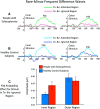Electrophysiological Evidence for Hyperfocusing of Spatial Attention in Schizophrenia
- PMID: 28283557
- PMCID: PMC5394898
- DOI: 10.1523/JNEUROSCI.3221-16.2017
Electrophysiological Evidence for Hyperfocusing of Spatial Attention in Schizophrenia
Abstract
A recently proposed hyperfocusing hypothesis of cognitive dysfunction in schizophrenia proposes that people with schizophrenia (PSZ) tend to concentrate processing resources more narrowly but more intensely than healthy control subjects (HCS). The present study tests a key prediction of this hypothesis, namely, that PSZ will hyperfocus on information presented at the center of gaze. This should lead to greater filtering of peripheral stimuli when the task requires focusing centrally but reduced filtering of central stimuli when the task requires attending broadly in the periphery. These predictions were tested in a double oddball paradigm, in which frequent standard stimuli and rare oddball stimuli were presented at central and peripheral locations while event-related potentials were recorded. Participants were instructed to discriminate between the standard and oddball stimuli at either the central location or at the peripheral locations. PSZ and HCS showed opposite patterns of spatial bias at the level of early sensory processing, as assessed with the P1 component: PSZ exhibited stronger sensory suppression of peripheral stimuli when the task required attending narrowly to the central location, whereas HCS exhibited stronger sensory suppression of central stimuli when the task required attending broadly to the peripheral locations. Moreover, PSZ exhibited a stronger stimulus categorization response than HCS, as assessed with the P3b component, for central stimuli when the task required attending to the peripheral region. These results provide strong evidence of hyperfocusing in PSZ, which may provide a unified mechanistic account of multiple aspects of cognitive dysfunction in schizophrenia.SIGNIFICANCE STATEMENT Schizophrenia clearly involves impaired attention, but attention is complex, and delineating the precise nature of attentional dysfunction in schizophrenia has been difficult. The present study tests a new hyperfocusing hypothesis, which proposes that people with schizophrenia (PSZ) tend to concentrate processing resources more intensely but more narrowly than healthy control subjects (HCS). Using electrophysiological measures of sensory and cognitive processing, we found that PSZ were actually superior to HCS in focusing attention at the point of gaze and filtering out peripheral distractors when the task required a narrow focusing of attention. This finding of superior filtering in PSZ supports the hyperfocusing hypothesis, which may provide the mechanism underlying a broad range of cognitive impairments in schizophrenia.
Keywords: attention; event-related potential; hyperfocusing; p300; schizophrenia.
Copyright © 2017 the authors 0270-6474/17/373813-11$15.00/0.
Figures






References
-
- Andreasen NC. (1984) Scale for the assessment of negatives symptoms (SANS). Iowa City, IA: University of Iowa.
-
- Ball K, Owsley C (1993) The useful field of view test: a new technique for evaluating age-related declines in visual function. J Am Optom Assoc 64:71–79. - PubMed
-
- Ball K, Roenker DL (1998) UFOV useful field of view manual. San Antonio, TX: Psychological Corporation.
Publication types
MeSH terms
Grants and funding
LinkOut - more resources
Full Text Sources
Other Literature Sources
Medical
Miscellaneous
